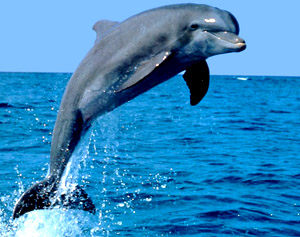Environmentalists cheer dolphin as national aquatic animal
 Patna, Oct 6 Environmentalists in Bihar are overjoyed at the dolphin being declared a national aquatic animal and say the move would not only save the freshwater species from extinction but an increase in their numbers would also indicate a cleaner Ganga river.
Patna, Oct 6 Environmentalists in Bihar are overjoyed at the dolphin being declared a national aquatic animal and say the move would not only save the freshwater species from extinction but an increase in their numbers would also indicate a cleaner Ganga river.
"It will boost the conservation of dolphins in India," said R. K. Sinha, a well-known expert on Gangetic dolphins.
According to him, dolphins are the lifeline of river Ganga. "If the dolphin numbers increase in the river, it will be a positive sign for a clean Ganges and if the numbers decrease, it is a negative sign of increasing pollution," Sinha told IANS.
The decision to declare the dolphin as an Indian national aquatic animal was taken Monday at a meeting of the newly-formed Ganga River Basin Authority (GRBA) in New Delhi that called for accelerated steps to clean up the river, revered as sacred by many Indians. The meet was chaired by Prime Minister Manmohan Singh.
Sinha, who has been researching on river dolphins for over two decades, also pointed out that immersion of idols during Hindu festivals poses a grave threat to the river and aquatic life. He suggested that "man-made water bodies" be used for immersing idols instead of the Ganga.
"The Ganga, which is already highly polluted, and its eco-system are under pressure and the immersed idols will create more trouble for dolphins and people dependent on the river for drinking water," said Sinha, a zoology professor at Patna University.
Till a decade ago, idols were made of clay and decorated with vegetable colours and other biodegradable material. "Now idols are made of plaster of paris, synthetic colours and decorated with non-biodegradable material that are not at all friendly to the river," he stressed.
Guddu Baba, another environmentalist who is associated with the Ganga Bachao Andolan, said that endangered dolphins in the Ganges, which continue to die of pollution and activities like fishing, may now get a new lease of life.
Sunil Choudhary, a wildlife expert, said that efforts to conserve dolphins would bear fruit now unlike the earlier measures that remained on paper.
He recalled that Bihar Chief Minister Nitish Kumar, alarmed over the dwindling number of the rare river dolphins in the Ganga, had announced a move to save the species last year. But the efforts did not move beyond government files, Choudhary said.
A report released by international NGO World Wide Fund for Nature (WWF) two years ago said the Ganga was among the 10 big rivers in the world facing extinction.
Untreated sewage, rotting carcasses and industrial effluents that find their way into the Ganga during its 2,500-km-long journey across several states from the Himalayas to the Bay of Bengal have also affected the dolphins, Sinha said.
Researchers estimate the dolphin population across India to be a little over 1,500. Half of these are found in the Ganga in Bihar and Uttar Pradesh. The numbers have dropped drastically over the past decades - in the 1980s, the Gangetic delta zone alone had around
3,500 dolphins.
In 1996, freshwater dolphins - locally known as 'sons of the river' - were categorised as an endangered species by the World Conservation Union - a forum of conservationists, NGOs and government agencies.
The dolphins in the Ganga are among the four freshwater dolphin species in the world. The other three are found in the river Yangtze in China, in the Indus in Pakistan and in the Amazon in South America. (IANS)